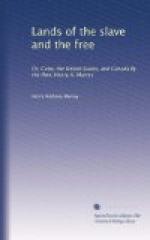The average value of the bale (450lbs.) of main land cotton is from 6l. to 8l. sterling; of the sea-island cotton, from 30_l_ to 36l. sterling. The average price of a tierce of rice (600lbs.) is from 3l. 5s. to 4l.]
[Footnote AH: Independent of the enormous charge of fifty per cent. on the taxes you pay, there is also a small fine for each parade missed.]
[Footnote AI: Vide chapter on “Military Education.”]
[Footnote AJ: Vide chapter on “The Constitution.”]
CHAPTER XV.
From a River to a Racecourse.
Having enjoyed as much of the hospitalities of my kind friends as time permitted, I obtained a letter of introduction, and, embarking in a steamer, started for Williamsburg, so called after King William III. On our way down, we picked up as healthy and jolly a set of little ducks in their ’teens as one could wish to see. On inquiring what this aggregate of rosy cheeks and sunny smiles represented, I was informed they were the sum total of a ladies’ school at Williamsburg—and a very charming sum total they were. Having a day’s holiday, they had come up by the early steamer to pic-nic on the banks, and were now returning to chronology and crotchet-work, or whatever else their studies might be. Landing at King’s Mills, a “’bus” took us all up to Williamsburg, a distance of three or four miles, one half of which was over as dreary a road as need be, and the other through a shady forest grove.
This old city is composed of a straight street, at one end of which is the establishment occupied by the rosy cheeks of whom we have been speaking, and which is very neat and clean-looking; at the other end—only with half a mile of country intervening—is the college. On each side of the said street is a crescent of detached houses, with a common before them. The population is 1500, and has not varied—as far as I could learn—in the memory of the oldest inhabitant. I naturally felt very much interest in visiting this place, as it was originally the seat of the royal government, and my grandfather had been the last governor of the state. The body of the old palace was burnt down by accident, while occupied by French troops, in 1782. The foundations, which were six feet thick, are still traceable, although most of the bricks have been used for the buildings in the neighbourhood. The outlines of the old garden and its terraces may also be traced, and a very charming spot it must have been. There are two beautiful lime-trees in a thriving state, which, I was told, he had planted himself from seeds he had brought from home. His thoughts were evidently on that far-off home when he planted them; for, as to position relatively to each other and distance from the old palace, they precisely coincide with two beneath which many of my early days were passed, at the old family mansion of Glenfinarl, on Loch Fine, which has since become the property of Mr. Douglas.




